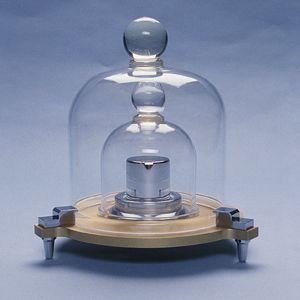K50 is going on a trip. Sometime soon, the golf-ball-size cylinder of platinum and iridium, which makes its home in Ottawa, will be carefully packed up and hand carried by a member of Canada’s diplomatic corps on a plane to France, with special instructions that its case not be opened by customs or airport security.
This precious cargo will join a small clutch of similar objects that will trickle into Paris in the coming weeks. Their destination: theInternational Bureau of Weights and Measures (BIPM) just outside the city, where they’ll be compared with one another to see just how well their estimated masses match up.
The exercise is a test, a dry run to see whether the world is ready for a shift in the way we define mass. Today, the International System of Units defines the kilogram by using a physical object: a supercentenarian cylinder called theInternational Prototype of the Kilogram (IPK). It is the progenitor of K50 and many other mass standard bearers. Although the IPK is stored in a vault and brought out only rarely, it is still a physical object, and so its mass can change. But because its mass is, by definition, 1 kilogram, any shifts that do occur essentially happen to the mass of everything else.
The world’s metrologists aim to change this state of affairs in 2018 by fixing the kilogram to the Planck constant, a fundamental physical constant. That shift would, at least in principle, allow any laboratory to “realize” the kilogram from scratch with a series of experiments and specialized equipment. But for that scheme to work, the kilogram derived by one laboratory must be the same as those derived by others. [For details of how this is done, see “The Kilogram Reinvented,” IEEE Spectrum, May 2012.]
“The question is, How would these independently realized kilograms agree?” says BIPM’s Michael Stock, who is leading the pilot study. Stock expects roughly half a dozen groups to weigh in. Two will hail from the national metrology institutes of Germany and Japan, which maintain ultrapure silicon spheres whose characteristics were recently measured with great precision—one possible way of determining the kilogram. The remaining groups will represent institutes that are working on watt balances, which measure masses against the electrical force needed to resist their weight.
There are a number of watt balances and similar electromechanical balances under construction around the world. But to participate in this pilot study, a group must demonstrate that it can measure a kilogram with an uncertainty of 0.00002 percent or less, meaning it can’t be off by more than 200 micrograms.
“We are ready to go,” says Carlos Sanchez, discipline leader for electrical standards at Canada’s National Research Council. As IEEE Spectrum went to press, he and his colleague Richard Green were working through a series of measurements that would calibrate K50 against masses measured in the group’s watt balance. The apparatus recently achieved an uncertainty of just 18 micrograms, currently the lowest published and well below BIPM’s requirement.
But a critical test will be how well other measurements agree. Previous experiments, which effectively flip the watt-balance measurement around so that masses are used to measure the Planck constant, have not been in perfect accord.
BIPM hopes to receive all the test masses by the end of March, although the list of participants and their expected arrival times was still being finalized at press time. The comparison measurements will take some months, and the results are not likely to be available before next year.
The outcome of the test is uncertain. So, too, is the fate of the kilogram in 2018. “If everything goes well, [the comparisons] would confirm that the future system would work. If it’s not satisfactory, it could be an obstacle [to the redefinition],” Stock says. “So it’s definitely going to be interesting.”
[Source:- Spectrum_IEEE]


